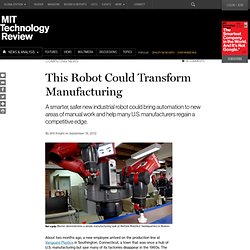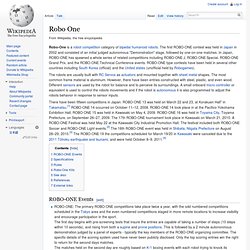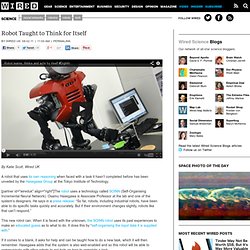

This Robot Could Transform Manufacturing. Get a grip: Baxter demonstrates a simple manufacturing task at Rethink Robotics’ headquarters in Boston.

About two months ago, a new employee arrived on the production line at Vanguard Plastics in Southington, Connecticut, a town that was once a hub of U.S. manufacturing but saw many of its factories disappear in the 1960s. The small manufacturer’s new worker, Baxter, is six feet tall, 300 pounds, and a robot. For a hulking machine, Baxter is remarkably expressive.
A pair of eyes on the screen that serves as a face stare down as the robot picks up plastic components, look concerned when it makes a mistake, and direct its glance at its next task when one is finished. It’s cute. Baxter is the first of a new generation of smarter, more adaptive industrial robots. Baxter’s talents could, for the first time, bring the benefits of robotics and automation to areas of work where it never made sense before. The result is something very different indeed. Baxter requires no such barriers. 'Most realistic' robot legs developed. 5 July 2012Last updated at 23:58 ET Experiment footage showing the robotic legs in action - Courtesy Journal of Neural Engineering US experts have developed what they say are the most biologically-accurate robotic legs yet.

Writing in the Journal of Neural Engineering, they said the work could help understanding of how babies learn to walk - and spinal-injury treatment. They created a version of the message system that generates the rhythmic muscle signals that control walking. A UK expert said the work was exciting because the robot mimics control and not just movement. The team, from the University of Arizona, were able to replicate the central pattern generator (CPG) - a nerve cell (neuronal) network in the lumbar region of the spinal cord that generates rhythmic muscle signals.
Robo One. Robo-One is a robot competition category of bipedal humanoid robots.

The first ROBO-ONE contest was held in Japan in 2002 and consisted of an initial judged autonomous "Demonstration" stage, followed by one-on-one matches. In Japan, ROBO-ONE has spawned a whole series of related competitions including ROBO-ONE J, ROBO-ONE Special, ROBO-ONE Grand Prix, and the ROBO-ONE Technical Conference events. ROBO-ONE type contests have been held in several other countries including South Korea (official) and the United states (unofficial held by Robogames). The robots are usually built with RC Servos as actuators and mounted together with sheet metal shapes. The most common frame material is aluminum. There have been fifteen competitions in Japan. Robo-One Competition. Do Robots Take People's Jobs? Last month, President Barack Obama announced the National Robotics Initiative, a major program to develop next-generation robots for manufacturing, healthcare, and other areas.

The robotics community received the new initiative with enthusiasm, but some observers expressed concern about an expansion in automation, raising a perennial question in robotics: Do robots take people’s jobs? “The real purpose of automating manufacturing is to eliminate skilled workers and replace them with low paid button pushers—preferably offshore,” commented one IEEE Spectrum reader who’s worked as a control engineer for 25 years. Said another: "As jobs at all levels, from McDonald's to college-educated knowledge-workers, are increasingly automated, there will be more unemployment.
" Other readers voiced similar concerns. To hear what the pro-robots camp has to say, I spoke to John Dulchinos [photo, right], president and CEO of Adept Technology, the largest U.S. industrial robotics company. Robots comfort tsunami refugees in Japan. Company: Time Magazine Names the XOS 2 Exoskeleton "Most Awesomest" Invention of 2010. Last updated: 10/27/2011* Raytheon’s second-generation exoskeleton (XOS 2), essentially a wearable robotics suit, has been named one of the Best Inventions of 2010 by Time Magazine .

The suit was unveiled for the first time in September during an event at the company’s Salt Lake City research facility. XOS 2 is lighter, stronger and faster than its predecessor, yet it uses 50 percent less power, and its new design makes it more resistant to the environment. The wearable robotics suit is being designed to help with the many logistics challenges faced by the military both in and out of theater. Repetitive heavy lifting can lead to injuries, orthopedic injuries in particular. . * The content on this page is classified as historical content. CBBC Newsround - Football World Cup - with robots! Japanese Engineers Create Human Powered Exoskeleton Suit (Video) Robot Taught to Think for Itself. By Katie Scott, Wired UK A robot that uses its own reasoning when faced with a task it hasn’t completed before has been unveiled by the Hasegawa Group at the Tokyo Institute of Technology.

[partner id="wireduk" align="right"]The robot uses a technology called SOINN (Self-Organising Incremental Neural Network). Osamu Hasegawa is Associate Professor at the lab and one of the system’s designers. He says in a press release: “So far, robots, including industrial robots, have been able to do specific tasks quickly and accurately. But if their environment changes slightly, robots like that can’t respond.”
This new robot can. If it comes to a blank, it asks for help and can be taught how to do a new task, which it will then remember. When it learns to make the perfect gin and tonic, I want one. Video: Diginfonews/YouTube Source: Wired.co.uk.